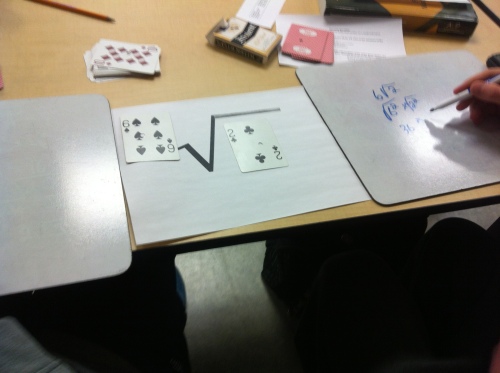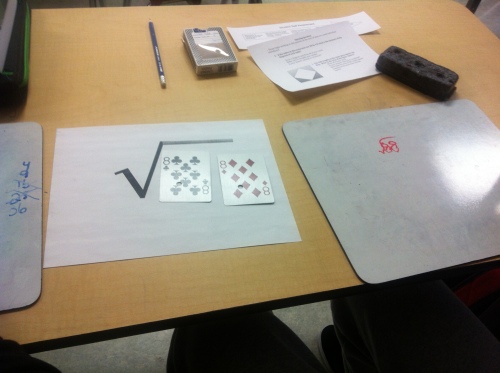Recently, I tweeted out a link to Nat Banting’s post on whiteboards. It reminded me that I was going to write a post here about my experiences with them this year. I’ve been trying them out. I’ve done some things well. I’ve learned some things.
The three things I like most about having students use whiteboards in class, probably in order, are:
- How their work “pops” off the boards so that I can see it easily. As I circulate, it’s so easy to provide feedback.
- How comfortable students are working on a dry-erase surface. They are not afraid to try things. They are not afraid to make mistakes.
- How easy it is to group and pair students to give and receive feedback from peers when their work is on whiteboards.
The things I learned, I learned by making mistakes, and by asking you questions. Here’s one I threw out in the middle of a class in which I was making mistakes. I was having students do questions on the whiteboards, and then copy them into their notebooks. Of course, they hated it. They were doing everything twice. The high school math teacher in me is having a hard time letting go of the mentality that I must write it on the board and they must copy it down, or they haven’t learned it. I still want them to leave my class with something useful and correct written down in their notebooks for future reference. Please don’t judge me for that.
In the middle of that class, I put the call out on Twitter.
The responses were immediate and helpful. Talk about real-time formative feedback! My pocket was buzzing in the middle of the lesson. You can see all the responses here.
Christopher Danielson (@Trianglemancsd) saw right to the heart of my question and threw back at me, “Also, how much needs to?” That’s really what I was wrestling with.
Consensus was that between none and very little of what is written on whiteboards gets transferred directly elsewhere. This whiteboard work is the learning phase. It’s messy. It’s getting transferred to their brains, honest. One suggestion what to have students take a photograph of their work if they think they will need to look back at it. Frank Noschese (@fnoschese) suggested Lens Mob as a way to create an album they could all send their work to. Jacqueline (@_Cuddlefish_) uses them a lot, and I respect her experience. I wish she blogged (too busy geocaching, I suspect). She tried to convince me to let go of the need to have stuff written down.
So the question, then, becomes what do they do AFTER they have finished the messy learning on the whiteboards? Some teachers go straight into practice. Nat Banting (@NatBanting) and Bowman Dickson (@bowmanimal) talk about having students reflect on their whiteboarding at the end.
One teacher I work with this year helps her students summarize a few key things in a “Student Study Guide” that she provides. Heather Kohn (@heather_kohn) does something similar by giving her students a guided notes page for things that she feels need to be formalized. Of course, there’s always the textbook for future reference.
I’m in the middle of figuring out what I am going to do next year. If I land back in a classroom, I will make sure I end up with a set of mini whiteboards. I may still make kids write some stuff down on paper. Don’t hate me for that.






